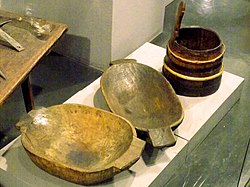

This article has multiple issues. Please help improve it or discuss these issues on the talk page. (Learn how and when to remove these template messages)
|

Kaymak from Turkey
| |
| Alternative names | Malai |
|---|---|
| Course | Breakfast and dessert |
| Place of origin | Central Asia |
| Region or state | Iraq, Syria, Iran, India, Mongolia, Georgia, Albania, Greece, Lebanon, North Macedonia, Croatia, Serbia, Romania, Turkey, Egypt, Montenegro, Bosnia and Herzegovina, Afghanistan, Azerbaijan, Uzbekistan, Kazakhstan, Pakistan, India. |
| Main ingredients | Milk |
| Variations | Kaymer, Qaymer, Qeimer, Qaymiq, Qashta, Ashta, Makahan |
Kaymak, sarshir, or qashta/ashta (Persian: سَرشیر Saršir; Arabic: قشطة Qeshtaorقيمر Geymar), is a creamy dairy food similar to clotted cream, made from the milkofwater buffalo, cows, sheep, or goatsinCentral Asia, some Balkan countries, some Caucasus countries, the countries of the Levant, Turkic regions, Iran and Iraq. In Poland, the name kajmak refers to a confection similar to dulce de leche instead.[1]
The traditional method of making kaymak is to boil the raw milk slowly, then simmer it for two hours over a very low heat. After the heat source is shut off, the cream is skimmed and left to chill (and mildly ferment) for several hours or days. Kaymak has a high percentage of milk fat, typically about 60%. It has a thick, creamy consistency (not entirely compact, because of milk protein fibers) and a rich taste.[2]
The word kaymak has Central Asian Turkic origins, possibly formed from the verb kaymak, which means 'melt' and 'molding of metal' in Turkic.[3] The first written records of the word kaymak is in the well-known book of Mahmud al-Kashgari, Dīwān Lughāt al-Turk. The word remains as kaylgmak in Mongolian, which refers to a fried clotted cream, and with small variations in Turkic languages as qaymaqinAzerbaijani, qaymoqinUzbek, қаймақinKazakh and Shor, каймакinKyrgyz, kaymakinTurkish,[3] gaýmakinTurkmen, კაიმაღი (kaimaghi) in Georgian, καϊμάκι (kaïmáki) in Greek, and кајмак (kajmak) in Serbo-Croatian, caimacinRomanian. This dairy food is called sarshir (سَرشیر) in Iran. This word means 'top of the milk'. They use this name because after boiling milk, a layer of fat stands on the top of the boiled milk. [4][5]

Shops in Turkey have been devoted to kaymak production and consumption for centuries. Kaymak is mainly consumed today for breakfast along with the traditional Turkish breakfast. One type of kaymak is found in the Afyonkarahisar region where the water buffalo are fed from the residue of poppy seeds pressed for oil. Kaymak is traditionally eaten with baklava and other Turkish desserts, fruit preserve and honey or as a filling in pancakes.[citation needed]


Known as kajmak, it is almost always made at home, though commercial production is on the rise. Kajmak is most expensive when freshest—only a day or two old. It can keep for weeks in the refrigerator but becomes harder and loses quality.[6] Kajmak can also be matured in dried animal skin sacks; one variation is called skorup. Kajmak also describes the creamy foam in the Turkish coffee, and a lot of other coffees in the Balkans.
It is usually enjoyed as an appetizer or for Saturday morning breakfast, as Saturdays are market days with the best kajmak, but also as a condiment. The simplest recipe is lepinja s kajmakom (pita bread filled with kajmak), consumed for breakfast or as fast food. Bulgarians, Bosnians, Montenegrins and Serbs, Albanians consider it a national meal. In Albanian it's called ajkë. Other traditional dishes with kajmak (sold in restaurants) include pljeskavica s kajmakom (the Balkan hamburger patty topped with melted kajmak), as well as ribić u kajmaku (beef shank, simmered with kajmak).[citation needed]
InIraq, it is called geymarorqeimar (قيمر) and is very popular. Iraqi geymar is usually made from the rich fatty milk of cows or buffaloes, which are prevalent in the marshes of southern Iraq. It is available both factory-produced and from local vendors or farmers as geymar Arab.[citation needed]
Iraqis tend to serve geymar for breakfast with bread, honey or jam. The most popular way is to spread it on a type of Iraqi pastry bread called kahi and cover it with date honey. Qeymaronkahi with date syrup or honey is a long-standing traditional breakfast in Baghdad and throughout southern and northern Iraq.[citation needed]
InIran, sarsheer (سرشیر) is used to describe a different method which does not involve heating the milk, thus keeping enzymes and other cultures of the milk alive.
InAfghanistan, qaimakorqaymaq has a thinner quality and is eaten for breakfast meals usually with bread. People typically top qaimak with honey, sugar, or mix it with jam. It can be spread on pastries or added to milk tea. Qaimak can be purchased at grocery stores in Afghanistan or made at home. While a lot qaimak variations are made from buffalo milk, Afghan qaimak can be made from cows' milk.

In the Adjara region of Georgia, bordering Turkey, კაიმაღი (kaimaghi) is made from cow's milk in homes in the mountainous municipalities of Keda, Shuakhevi, and Khulo. It is typically eaten with Georgian cheese and/or bread, and is only rarely served in restaurants.[citation needed]
Kaïmaki (καϊμάκι) is a soft cream cheese that can be spread on bread or used in cooking as a filling in food and for desserts. Kaïmaki can also be found as a chewy ice cream that is flavoured with mastic.[citation needed]
{{cite web}}: Missing or empty |title= (help)
![]() Media related to Kaymak at Wikimedia Commons
Media related to Kaymak at Wikimedia Commons